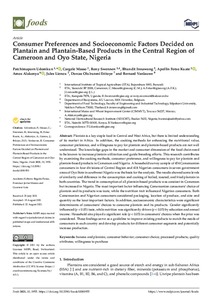| dc.contributor.author | Udomkun, P. |
| dc.contributor.author | Masso, C. |
| dc.contributor.author | Swennen, R. |
| dc.contributor.author | Innawong, B. |
| dc.contributor.author | Fotso Kuate, A. |
| dc.contributor.author | Alakonya, A. |
| dc.contributor.author | Lienou, J. |
| dc.contributor.author | Ibitoye, D.O. |
| dc.contributor.author | Vanlauwe, B. |
| dc.date.accessioned | 2021-09-27T12:48:49Z |
| dc.date.available | 2021-09-27T12:48:49Z |
| dc.date.issued | 2021 |
| dc.identifier.citation | Udomkun, P., Masso, C., Swennen, R., Innawong, B., Fotso Kuate, A., Alakonya, A., ... & Vanlauwe, B. (2021). Consumer preferences and socioeconomic factors decided on plantain and plantain-based products in the central region of Cameroon and Oyo state, Nigeria. Foods, 10(8), 1955: 1-18. |
| dc.identifier.issn | 2304-8158 |
| dc.identifier.uri | https://hdl.handle.net/20.500.12478/7259 |
| dc.description.abstract | Plantain is a key staple food in Central and West Africa, but there is limited understanding of its market in Africa. In addition, the cooking methods for enhancing the nutritional value, consumer preference, and willingness to pay for plantain and plantain-based products are not well understood. The knowledge gaps in the market and consumer dimension of the food chain need to be known to increase plantain utilization and guide breeding efforts. This research contributes by examining the cooking methods, consumer preference, and willingness to pay for plantain and plantain-based products in Cameroon and Nigeria. A household survey sample of 454 Cameroonian consumers in four divisions of Central Region and 418 Nigerian consumers in seven government areas of Oyo State in southwest Nigeria was the basis for the analysis. The results showed some levels of similarity and difference in the consumption and cooking of boiled, roasted, and fried plantain in both countries. The trend in consumption of all plantain-based products was constant in Cameroon but increased in Nigeria. The most important factor influencing Cameroonian consumers’ choice of plantain and its products was taste, while the nutrition trait influenced Nigerian consumers. Both Cameroonian and Nigerian consumers considered packaging, location of produce, and size and quantity as the least important factors. In addition, socioeconomic characteristics were significant determinants of consumers’ choices to consume plantain and its products. Gender significantly influenced (p < 0.05) taste, while nutrition was significantly driven (p < 0.05) by education and annual income. Household size played a significant role (p < 0.05) in consumers’ choices when the price was considered. These findings serve as a guideline to improve existing products to match the needs of consumers in each country and develop products for different consumer segments and potentially increase production. |
| dc.description.sponsorship | African Union Research Grants |
| dc.format.extent | 1-18 |
| dc.language.iso | en |
| dc.subject | Bananas |
| dc.subject | Plantains |
| dc.subject | Consumer Behaviour |
| dc.subject | Processed Products |
| dc.subject | Quality |
| dc.subject | Willingness to Purchase |
| dc.title | Consumer preferences and socioeconomic factors decided on plantain and plantain-based products in the central region of Cameroon and Oyo state, Nigeria |
| dc.type | Journal Article |
| cg.contributor.crp | Agriculture for Nutrition and Health |
| cg.contributor.crp | Maize |
| cg.contributor.crp | Roots, Tubers and Bananas |
| cg.contributor.affiliation | International Institute of Tropical Agriculture |
| cg.contributor.affiliation | Katholieke Universiteit, Leuven |
| cg.contributor.affiliation | Silpakorn University |
| cg.contributor.affiliation | International Maize and Wheat Improvement Center |
| cg.contributor.affiliation | National Horticultural Research Institute |
| cg.coverage.region | Africa |
| cg.coverage.region | Central Africa |
| cg.coverage.region | West Africa |
| cg.coverage.country | Cameroon |
| cg.coverage.country | Nigeria |
| cg.coverage.hub | Central Africa Hub |
| cg.coverage.hub | Headquarters and Western Africa Hub |
| cg.researchtheme | Biotech and Plant Breeding |
| cg.researchtheme | Natural Resource Management |
| cg.researchtheme | Nutrition and Human Health |
| cg.researchtheme | Plant Production and Health |
| cg.identifier.bibtexciteid | UDOMKUN:2021c |
| cg.isijournal | ISI Journal |
| cg.authorship.types | CGIAR and developing country institute |
| cg.iitasubject | Agronomy |
| cg.iitasubject | Banana |
| cg.iitasubject | Food Security |
| cg.iitasubject | Nutrition |
| cg.iitasubject | Plant Breeding |
| cg.iitasubject | Plant Health |
| cg.iitasubject | Plant Production |
| cg.iitasubject | Plantain |
| cg.iitasubject | Smallholder Farmers |
| cg.iitasubject | Socioeconomy |
| cg.iitasubject | Value Chains |
| cg.journal | Foods |
| cg.notes | Open Access Journal; Published online: 22 Aug 2021 |
| cg.accessibilitystatus | Open Access |
| cg.reviewstatus | Peer Review |
| cg.usagerightslicense | Creative Commons Attribution 4.0 (CC BY 0.0) |
| cg.targetaudience | Scientists |
| cg.identifier.doi | https://dx.doi.org/10.3390/foods10081955 |
| cg.iitaauthor.identifier | Patchimaporn Udomkun: 0000-0003-0115-1997 |
| cg.iitaauthor.identifier | Cargele Masso: 0000-0002-3980-6832 |
| cg.iitaauthor.identifier | Rony Swennen: 0000-0002-5258-9043 |
| cg.iitaauthor.identifier | Fotso Kuate, A.: 0000-0002-5247-7519 |
| cg.iitaauthor.identifier | amos Alakonya: 0000-0001-7710-499X |
| cg.iitaauthor.identifier | bernard vanlauwe: 0000-0001-6016-6027 |
| cg.futureupdate.required | No |
| cg.identifier.issue | 8: 1955 |
| cg.identifier.volume | 10 |

